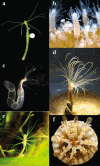Cnidofest 2018: the future is bright for cnidarian research
- PMID: 31508195
- PMCID: PMC6724248
- DOI: 10.1186/s13227-019-0134-5
Cnidofest 2018: the future is bright for cnidarian research
Abstract
The 2018 Cnidarian Model Systems Meeting (Cnidofest) was held September 6-9th at the University of Florida Whitney Laboratory for Marine Bioscience in St. Augustine, FL. Cnidofest 2018, which built upon the momentum of Hydroidfest 2016, brought together research communities working on a broad spectrum of cnidarian organisms from North America and around the world. Meeting talks covered diverse aspects of cnidarian biology, with sessions focused on genomics, development, neurobiology, immunology, symbiosis, ecology, and evolution. In addition to interesting biology, Cnidofest also emphasized the advancement of modern research techniques. Invited technology speakers showcased the power of microfluidics and single-cell transcriptomics and demonstrated their application in cnidarian models. In this report, we provide an overview of the exciting research that was presented at the meeting and discuss opportunities for future research.
Keywords: Aiptasia; Cassiopeia; Cnidarians; Hydra; Hydractinia; Nematostella.
Conflict of interest statement
Competing interestsThe authors declare that they have no competing interests.
Figures


References
-
- Hyman LH. The invertebrates. 1. New York: McGraw-Hill; 1940.
-
- Haeckel E. Kunstformen der Natur. Leipzig und Wien: Verlag des Bibliographischen Instituts; 1899. p. 2.
-
- Trembley A, Pronk C, Schley Jvd, Lyonet P, J. et H. Verbeek. Mémoires pour servir à l’histoire d’un genre de polypes d’eau douce, à bras en forme de cornes. A Leide,: chez Jean & Herman Verbeek. xv, 1, 324, 2 p., 13 folded leaves of plates p.

